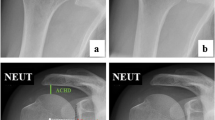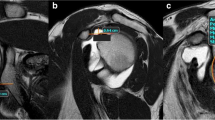Abstract
Purpose
The present study was performed to determine the translation of the glenohumeral joint in patients with and without shoulder lesions by comparing the magnetic resonance images obtained in the conventional adducted neutral rotation position with those obtained in the abducted externally rotated position.
Methods
Two hundred and eighty-five consecutive shoulders without rotator cuff tears that had been subjected to magnetic resonance imaging (MRI) without arthrography in the abducted externally rotated position were reviewed retrospectively. Among them, 50 shoulders without pathology were selected at random to be compared with three shoulder pathology groups, comprising shoulders with superior labrum, anterior-to-posterior (SLAP) lesions without range of motion (ROM) limitation (group I, 47 shoulders), with massive rotator cuff tears without ROM limitation (group II, 20 shoulders), and with full-thickness subscapularis tendon tears without ROM limitation (group III, 20 shoulders). Glenohumeral translation in the anterior-to-posterior direction relative to the glenoid face was evaluated using a method based on the glenohumeral contact point (CP) and humeral head centre (HHC) in the adducted neutral rotation and abducted externally rotated views, which were measured by three orthopaedic surgeons. For each shoulder, the differences in translation for the glenohumeral CP and HHC between the adducted neutral rotation and abducted externally rotated views were calculated as relative posterior translation in millimetres.
Results
The differences in ΔCP and ΔHHC between group I and the normal control group were not statistically significant. The differences in ΔCP (P = 0.001) and ΔHHC (P = 0.001) between group II and the normal control group were statistically significant. Additionally, the differences in ΔCP and ΔHHC between group III and the normal control group were not statistically significant.
Conclusions
The MRI in abducted externally rotated view in patients with SLAP lesions or full-thickness subscapularis tendon tears diagnosed by conventional MRI alone showed no significant glenohumeral posterior translation relative to the adducted neutral rotation view in the present study. However, the abducted externally rotated view in patients with massive rotator cuff tears showed significant glenohumeral anterior translation relative to the adducted neutral rotation view.
Level of evidence
Diagnostic study, Level II.


Similar content being viewed by others
References
Burkart A, Debski RE, Musahl V, McMahon PJ (2003) Glenohumeral translations are only partially restored after repair of a simulated type II superior labral lesion. Am J Sports Med 31:56–63
Burkhart SS, Morgan CD, Kibler WB (2003) The disabled throwing shoulder: spectrum of pathology. Part I: pathoanatomy and biomechanics. Arthroscopy 19:404–420
Burkhart SS, Morgan CD, Kibler WB (2003) The disabled throwing shoulder: spectrum of pathology. Part II: evaluation and treatment of SLAP lesions in throwers. Arthroscopy 19:531–539
Burkhart SS, Morgan CD, Kibler WB (2003) The disabled throwing shoulder: spectrum of pathology. Part III: the SICK scapula, scapular dyskinesis, the kinetic chain, and rehabilitation. Arthroscopy 19:641–661
Chhadia AM, Goldberg BA, Hutchinson MR (2010) Abnormal translation in SLAP lesions on magnetic resonance imaging abducted externally rotated view. Arthroscopy 26(1):19–25
Cvitanic O, Tirman PF, Feller JF, Bost FW, Minter J, Carroll KW (1997) Using abduction and external rotation of the shoulder to increase the sensitivity of MR arthrography in revealing tears of the anterior glenoid labrum. AJR Am J Roentgenol 169:837–844
Grossman MG, Tibone JE, McGarry MH, Schneider DJ, Veneziani S, Lee TQ (2005) A cadaveric model of the throwing shoulder: a possible etiology of superior labrum anterior-to-posterior lesions. J Bone Joint Surg Am 87:824–831
Heath TL, Aberdein A (2006) Book 3. Proposition 25. Given a segment of a circle, to describe the complete circle of which it is a segment. In: Euclid, the elements: books I–XIII, complete and unabridged. Barnes & Noble, New York
Howell SM, Galinat BJ, Renzi AJ, Marone PJ (1988) Normal and abnormal mechanics of the glenohumeral joint in the horizontal plane. J Bone Joint Surg Am 70:227–232
Itoi E, Morrey BF, An K (2004) Biomechanics of the shoulder. In: Rockwood CA Jr, Matsen FA III, Wirth MA, Lippitt SB (eds) The shoulder. Saunders, Philadelphia, pp 223–268
Kwak SM, Brown RR, Trudell D, Resnick D (1998) Glenohumeral joint: comparison of shoulder positions at MR arthrography. Radiology 208:375–380
Magit DP, Tibone JE, Lee TQ (2008) In vivo comparison of changes in glenohumeral translation after arthroscopic capsulolabral reconstructions. Am J Sports Med 36:1389–1396
Matsen FA III, Titelman RM, Lippitt SB, Rockwood CA Jr, Wirth MA (2004) Glenohumeral instability. In: Rockwood CA Jr, Matsen FA III, Wirth MA, Lippitt SB (eds) The shoulder. Saunders, Philadelphia, pp 655–790
McMahon PJ, Burkart A, Musahl V, Debski RE (2004) Glenohumeral translations are increased after a type II superior labrum anterior-posterior lesion: a cadaveric study of severity of passive stabilizer injury. J Shoulder Elbow Surg 13:39–44
Mihata T, McGarry MH, Tibone JE, Fitzpatrick MJ, Kinoshita M, Lee TQ (2008) Biomechanical assessment of type II superior labral anterior-posterior (SLAP) lesions associated with anterior shoulder capsular laxity as seen in throwers: a cadaveric study. Am J Sports Med 36:1604–1610
Mileski RA, Snyder SJ (1998) Superior labral lesions in the shoulder: pathoanatomy and surgical management. J Am Acad Orthop Surg 6:121–131
Pagnani MJ, Deng XH, Warren RF, Torzilli PA, Altchek DW (1995) Effect of lesions of the superior portion of the glenoid labrum on glenohumeral translation. J Bone Joint Surg Am 77:1003–1010
Panossian VR, Mihata T, Tibone JE, Fitzpatrick MJ, McGarry MH, Lee TQ (2005) Biomechanical analysis of isolated type II SLAP lesions and repair. J Shoulder Elbow Surg 14:529–534
Poppen NK, Walker PS (1976) Normal and abnormal motion of the shoulder. J Bone Joint Surg Am 58:195–201
Tirman PF, Bost FW, Steinbach LS et al (1994) MR arthrographic depiction of tears of the rotator cuff: benefit of abduction and external rotation of the arm. Radiology 192:851–856
Shrout PE, Fleiss JL (1979) Intraclass correlations: uses in assessing reliability. Psychol Bull 86:420–428
Youm T, Tibone JE, ElAttrache NS, McGarry MH, Lee TQ (2008) Simulated type II superior labral anterior posterior lesions do not alter the path of glenohumeral articulation: a cadaveric biomechanical study. Am J Sports Med 36:767–774
Author information
Authors and Affiliations
Corresponding author
Rights and permissions
About this article
Cite this article
Kim, K.C., Rhee, Y.G., Park, J.Y. et al. Anteroposterior translation of the glenohumeral joint in various pathologies: differences between shoulder MRI in the adducted neutral rotation and abducted externally rotated positions. Knee Surg Sports Traumatol Arthrosc 23, 2611–2616 (2015). https://doi.org/10.1007/s00167-013-2671-0
Received:
Accepted:
Published:
Issue Date:
DOI: https://doi.org/10.1007/s00167-013-2671-0




